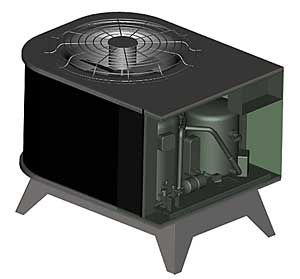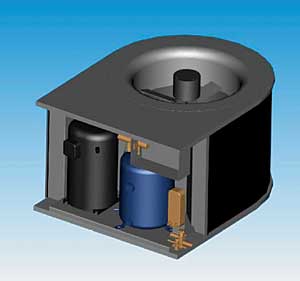Can a New Kind of Heat Pump Change the World?
Heat Pumps 101
Here's a refresher course on heat-pump basics. Refrigerants are the life-blood of every heat pump, refrigerator, or air-conditioning system. These materials are extremely efficient at absorbing thermal energy in one place, and moving and releasing it in another. Water is often used to move thermal energy in heating and air-conditioning. But the refrigerants used in heat pumps have many advantages over water. They don't freeze at 32 degrees Fahrenheit, and they boil at temperatures that are much lower than 212 degrees Fahrenheit. Their boiling points can also be raised or lowered significantly by pressurizing or depressurizing them, so when and where they are changed from a liquid state into a vapor or gas can be controlled. That's very useful, because it is when they are changing states that they do their work, absorbing heat when they are changing from a liquid to a gas, and releasing it when they are changing from a gas back into liquid. Old ozone-depleting refrigerants have been replaced by new ones that are also much more efficient at absorbing and giving up heat. Today, R410A is the most commonly used refrigerant for both residential and light-commercial systems.
To understand how refrigerant works, imagine a closed bottle full of it sitting in a cold place, and assume the container is partly full of liquid refrigerant and partly of the refrigerant in a gaseous state. If it was moved to a warm place, it would gradually absorb heat from its surroundings, and as it did so, the liquid refrigerant would boil, evaporating into a gas. The pressure inside the bottle would increase until the boiling stopped, because as the pressure in the bottle increased, so would the temperature at which the liquid boils. If the bottle was put back in a cool place, the vapor would give up heat into its surroundings, condense back into liquid, and the pressure in the bottle would decrease.
|
Now suppose that the bottle is replaced with a closed loop of tubing filled with refrigerant, half of it inside a building, where it's warm, and half outside, where it's cold. The refrigerant inside the tubing would change states constantly, boiling, evaporating, and condensing, moving heat from the inside of the building to the outside and returning for more. The only time it would stop changing states is when the temperature inside the building equaled the temperature outside. A heat pump does the opposite, using the refrigerant to gather heat from the air outside of the building and move it to the interior. To do this, it is necessary to add two components to the loop. One is a compressor (see opposite page, diagram 1), which pressurizes vapor so it can be turned into liquid inside an assembly, called the condenser. The condenser is made up of coils of tubing running through sheet-metal fins, which is installed downstream from the compressor. It provides lots of surface area, so the heat in the refrigerant can be transferred to the air efficiently when it condenses. When a heat pump is being used to heat a building, the condenser is placed inside, adjacent to a fan that forces the warm air into ductwork.
The other component needed to make a heat pump from the loop of refrigerant-filled tubing is an expansion valve. This device is placed downstream from the condenser. It restricts the flow of the refrigerant inside the condenser so the compressor can build up pressure that's necessary to condense the gas into a liquid. It also keeps this liquid from leaving the condenser before the heat it contains has fully transferred out of it. Expansion valves can be modulated, so that the amount of pressure in the condenser is variable, and the rate the condensed liquid leaves the condenser can be controlled. The pressure downstream from the expansion valve is much lower than it is in the condenser, so when warm liquid refrigerant leaves the condenser and is forced through the expansion valve, where the boiling point is also lower, some of it "flashes" into vapor. The temperature of liquid that left the condenser now becomes cold as it enters an assembly of pipes and sheet-metal fins, called the evaporator, which sits outside the building. It is at this point that any heat that remained in the warm liquid refrigerant after it left the expansion valve is boiled off into cold vapor. As it changes state, it absorbs heat from the outside air, helped along by the evaporator's large surface area. Soon, the thermal-energy-laden vapor is on its way back to the compressor to start the cycle all over again.
What differentiates a heat pump from an air conditioner used strictly for cooling is that the direction of the refrigerant flow can be reversed-the evaporator and condenser can be switched end-for-end, so one can deliver either heat or cooling to the inside of a building. In cooling mode, the condenser is outside, and the evaporator is inside.











